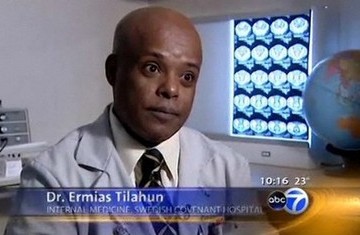By Desalegn Sisay | Afrik.com
A new consultancy firm that recently took administrative control of the Ethiopian capital, Addis Ababa, has expressed concern over a looming water related epidemic. The outbreak, which is expected between now and 2013, could hinder the achievement of the capital’s five-year strategic plan put together by the new consultancy firm. Meanwhile, Kuma Demeksa has outlined a 40 billion birr plan to address the city’s main problems during his tenure as the city’s mayor.
One of the major financial concerns of the draft strategy is to alleviate the housing and employment challenges facing the city’s 2.7 million residents. The plan includes the construction of 200,000 condominiums as well as the creation of 69,077 new jobs between 2011 and 2012. About a third of the city’s residents are currently unemployed.
The draft outlines a strategy to reduce unemployment by at least 51 per cent through a further development and encouragement of micro and small business enterprises. To achieve this set goal, the city intends to set aside 1.9 billion birr geared towards the creation of a lending mechanism in which small businesses could easily access financial support.
Waterborne diseases
Though the draft outlines a strategy to curb some of the major challenges affecting the development of the city, it also foresees the high improbability of reaching set targets owing to financial constraints and a possible outbreak of waterborne diseases.
According to their recent assessment, 25 per cent of Addis Ababa’s solid waste is not properly discharged while 25 per cent of the overall residential houses lack adequate lavatories. Out of the 800,000 cubic meters of the city’s daily waste only 10 per cent (that is, 8,024 cubic meters) was properly discharged last year, the document indicated.
Cases of contamination
The most alarming part of the findings indicate that the city’s poor sewerage system is bedded close to one of the main fresh water systems that supplies 37 percent of Addis Ababa’s water needs. There have been cases where residents were reportedly exposed to polluted water supply.
Meanwhile, the city is noted as lacking health institutions with only 10 hospitals. The federal government owns six of them. According to a World Health Organization requirement, a medical doctor is expected to treat a 10,000 patients while one nurse is to serve up to 1,000, however, a medical doctor in Addis Ababa treats 29,470 patients against 4,356 for a nurse.
Thursday, April 30, 2009
An Ethiopian doctor in Chicago performs life saving diagnosis

By Sylvia Perez and Christine Tressel | ABC News
Rahel Taye has a smile as big as her appetite. But a year ago her life now would be hard to imagine.
The 26-year-old from Ethiopia had been battling mysterious, crippling pains in her abdomen for months.
“Really, really bad, bad pain,” said Taye.
She was in and out of hospitals. No one had an answer for her but her health kept deteriorating.
She finally ended up at the emergency room of a prominent Chicago hospital where she says doctors delivered the devastating news: that she probably had ovarian cancer.
“The doctor told me she had two months to live,” said Solomon Melesse, Taye’s husband.
She was advised to have surgery which meant she might never have children. Rahel and her husband were stunned and in disbelief.
“I know they are wrong. I feel it,” said Taye.
Rahel trusted her instincts and was recommended to Ermias Tilahun, a specialist in internal medicine at Swedish Covenant Hospital. It was April of 2007. By then, Rahel was in very bad shape.
“She was less than 80 pounds when I saw her,” said Dr. Tilahun.
Like Rahel, Dr. Tilahun wasn’t convinced it was cancer. He had a hunch as a result of working with other immigrants and being Ethiopian himself.
At the time, Rahel was only 26, a very young age for ovarian cancer.
He ran several tests and then he discovered some white looking nodules all over the inside of her abdomen. That led him to suspect something no one else had; tuberculosis.
“After listening to their story, she migrated from Ethopia,” said Dr. Tilahun. “The probability for TB goes up.”
Tuberculosis is an infectious disease caused by a bacterium. It primarily attacks the lungs but doctors say the disease can affect other organs and tissues. That’s apparently what happened to Rahel. She was diagnosed with peritoneal TB, an unusual infection that some doctors may not know can mimic ovarian cancer.
Rahel was started on anti-TB medications. Within two weeks, they say she was eating and smiling. Since then the couple hasn’t looked back.
“Now we can have a family and live to have a family and kids,” said Rahel.
Dr. Tilahun says Rahel’s case is a perfect example of why U.S. doctors need to start looking beyond America’s borders in diagnosing illnesses.
As more people travel, different forms of disease are making their way to this country. TB is just one of them. In this case, a late diagnosis almost cost Rahel her life.
“If we didn’t consider TB for her she would not be around,” said Dr. Tilahun.
Rahel is now going to school and planning to have a family.
And even though it’s been more than year and half, the gravity of her ordeal is still overwhelming.
Dr. Tilahun says Rahel’s form of TB was not highly contagious. He is not sure how she got it but suspects she may have picked up the bacterium after drinking raw milk.
He also says that if he had used the gold standard test for TB which takes about four weeks, Rahel probably would have been dead. Dr. Tilahun says instead he used a test not well know here in the U.S. which got him results within a couple days.
For more information:
Dr. Ermias Tilahun
Swedish Covenant Hospital, Internal Medicine
2740 W. Foster Ave., Chicago, IL
773-907-3550
Subscribe to:
Posts (Atom)